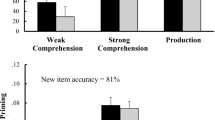Abstract
Learning through repetition is a fundamental form and also an effective method of language learning critical for achieving proficient and automatic language use. Massive repetition priming as a common research paradigm taps into the dynamic processes involved in repetition learning. Research with this paradigm has so far used only emotionally neutral materials and ignored emotional factors, which seems inappropriate given the well-documented impact of emotion on cognitive processing. The present study used massive repetition priming to investigate whether the emotional valence of learning materials affects implicit language learning. Participants read a list of Chinese words and made speeded perceptual judgments about the spatial configuration of the two characters in a word. Each word was repeated 15 times in the whole learning session. There were three types of words, negative, positive, or neutral in their emotional valence, presented in separate blocks. Although similar levels of asymptotic performance were reached for different valence conditions showing comparable total effects of learning, learning of the positive words was found to be associated with fewer plateaus of shorter durations and to reach saturation earlier, compared with neutral and negative words. The results showed for the first time that the emotional valence of learning materials has significant effects on the time course of learning so that positive materials are learned faster and more efficiently, relative to negative and neutral materials. The study indicates the importance to explicitly consider the role of emotional factors in implicit language learning research.
Similar content being viewed by others
References
Ashby F. G., Isen A. M., Turken A. U. (1999) A neuropsychological theory of positive affect and its influence on cognition. Psychological Review 106: 529–550
Beijing Language College Language Instruction Institute. (1986). Modern Chinese Frequency Dictionary (in Chinese). Beijing: Beijing Language College Press.
Bower G. H. (1981) Mood and memory. American psychologist 36: 129–148
Colagrosso, M. D., Mozer, M. C., & Huber, D. E. (2004). Mechanisms of skill learning: A model of long-term repetition priming. Paper presented at the Proceedings of the 25th Annual Conference of the Cognitive Science Society, Hillsdale, NJ.
Estrada C.A., Isen A.M., Young M.J. (1997) Positive affect facilitates integration of information and decrease anchoring in reasoning among physicians. Organizational Behavior and Human Decision 72: 117–135
Fenske M. J., Eastwood J. D. (2003) Modulation of focused attention by faces expressing emotion: evidence from flanker tasks. Emotion 3: 327–343
Franks I. M., Wilberg R. B. (1982) The generation of movement patterns during the acquisition of a pursuit tracking task. Human Movement Science 64: 251–272
Gatbonton E., Segalowitz N. (1988) Creative automatization: Principles for promoting fluency within a communicative framework. TESOL Quarterly 22: 473–492
Graf P., Mandler G. (1984) Activation makes words more accessible, but not necessarily more retrievable. Journal of Verbal Learning & Verbal Behavior 23: 553–568
Grant S. C., Logan G. D. (1993) The loss of repetition priming and automaticity over time as a function of degree of initial learning. Memory & cognition 21: 611–618
Hauptmann B., Karni A. (2002) From primed to learn: The saturation of repetition priming and the induction of long-term memory. Cognitive Brain Research 13: 313–322
Herbert C., Kissler J., Junghofer M., Peyk P., Rockstroh B. (2006) Processing of emotional adjectives: Evidence from startle EMG and ERPs. Psychophysiology 43: 197–206
Isen A. M. (1985) Asymmetry of happiness and sadness in effects on memory in normal college students: Comment on Hasher, Rose, Zackes, Sanft, and Doren. Journal of Experimental Psychology 114: 388–391
Isen A. M. (1987) Positive affect, cognitive processes, and social behavior. In: Berkowitz L. (eds) Advances in experimental social psychology. Academic Press, San Diego,CA
Isen, A. M. (1999). On the relationship between affect and creative problem solving. In S. Russ (Ed.), Affect, creative experience and psychological adjustment (pp. 3–17). Philadelphia: Brunner/Mazel.
Kort, B., & Reilly, R. (2002). Analytical models of emotions, learning, and relationships: Towards an affective-sensitive cognitive machine. Paper presented at the Proceedings of the ITS 2002—Intelligent Tutoring Systems.
Kuchinke L., Jacobs A. M., Grubich C., Vo M. L., Conrad M., Herrmann M. (2005) Incidental effects of emotional valence in single word processing: An fMRI study. Neuroimage 28: 1022–1032
LeDoux J. E. (1996) The emotional brain. Simon & Schuster, New York
Lewis M. B., Ellis H. D. (1999) Repetition priming of face recognition. The Quarterly Journal of Experimental Psychology Section A 52: 927–953
Lewis M. B., Ellis H. D. (2000) The effects of massive repetition on speeded recognition of faces. The Quarterly journal of experimental psychology 53: 1117–1142
Logan G. D. (1990) Repetition priming and automaticity: Common underlying mechanisms? Cognitive Psychology 22: 1–35
Ofen-Noy N., Dudai Y., Karni A. (2003) Skill learning in mirror reading: How repetition determines acquisition. Cognitive Brain Research 17: 507–521
Pessoa L. (2008) On the relationship between emotion and cognition. Nature Reviews Neuroscience 9: 148–158
Peterka R. J., Benolken M. S. (1995) Role of somatosensory and vestibular cues in attenuating visually induced human postural sway. Experimental brain research 105: 101–110
Salasoo A., Shiefrin R. M., Feustel T. C. (1985) Building permanent memory codes: Codification and repetition effects in word identification. Journal of Experimental Psychology: General 114: 50–77
Smith N. K., Larsen J. T., Chartrand T. L., Cacioppo J. T., Katafiasz H. A., Moran K. E. (2006) Being bad isn’t always good: Affective context moderates the attention bias toward negative information. Journal of Personality and Social Psychology 90: 210–220
Thomas L. A., Labar K. S. (2005) Emotional arousal enhances word repetition priming. Cognition & Emotion 19: 1027–1047
Author information
Authors and Affiliations
Corresponding author
Rights and permissions
About this article
Cite this article
Hu, Z., Liu, H. & Zhang, J.X. Effects of Material Emotional Valence on the Time Course of Massive Repetition Priming. J Psycholinguist Res 39, 199–211 (2010). https://doi.org/10.1007/s10936-009-9135-1
Published:
Issue Date:
DOI: https://doi.org/10.1007/s10936-009-9135-1




